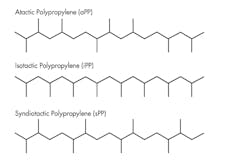Polypropylene (PP) is a rigid crystalline thermoplastic used in everyday objects. There are various types of PP available: homopolymer, copolymer, impact, etc. Its mechanical, physical, and chemical properties work well in applications ranging from automotive and medical to packaging.
What is Polypropylene?
Polypropylene is produced from propene (or propylene) monomer. It is a linear hydrocarbon resin. The chemical formula of polypropylene is (C3H6)n. PP is among the cheapest plastics available today, and It has the lowest density among commodity plastics. Upon polymerization, PP can form three basic chain structures depending on the position of the methyl groups:
- Atactic (aPP). Irregular methyl group (CH3) arrangement
- Isotactic (iPP). Methyl groups (CH3) arranged on one side of the carbon chain
- Syndiotactic (sPP). Alternating methyl group (CH3) arrangement
PP belongs to the polyolefin family of polymers and is one of the top-three most-used polymers today. Polypropylene has applications—both as a plastic and as a fiber—in the automotive industry, industrial applications, consumer goods, and the furniture market.
Different Types of Polypropylene
Homopolymers and copolymers are the two main types of polypropylene available in the market.
Propylene homopolymer is the most widely utilized general-purpose grade. It contains only propylene monomer in a semi-crystalline solid form. Main applications include packaging, textiles, healthcare, pipes, automotive, and electrical applications.
Polypropylene copolymer is divided into random copolymers and block copolymers produced by polymerizing of propene and ethane:
- Propylene random copolymer is produced by polymerizing together ethene and propene. It features ethene units, usually up to 6% by mass, incorporated randomly in the polypropylene chains. These polymers are flexible and optically clear, making them suitable for applications requiring transparency and for products requiring an excellent appearance.
- Propylene block copolymer contains a higher ethene content (between 5 and 15%). It has co-monomer units arranged in a regular pattern (or blocks). The regular pattern makes the thermoplastic tougher and less brittle than the random co-polymer. These polymers are suitable for applications requiring high strength, such as industrial usages.
Another type of polypropylene is impact copolymer. A propylene homopolymer containing a co-mixed propylene random copolymer phase which has an ethylene content of 45-65% is referred to PP impact copolymer. Impact copolymers are mainly used in packaging, houseware, film, and pipe applications, as well as in the automotive and electrical segments.
Polypropylene suppliers include A. Schulman, Borealis, ExxonMobil Chemical, LyondellBasell, SABIC, and RTP Company. For a full list of commercial grades and PP suppliers, click here.
Polypropylene Homopolymer vs. Polypropylene Copolymer
Propylene homopolymer has a high strength-to-weight ratio, and is stiffer and stronger than the copolymer. These properties combined with good chemical resistance and weldability make it a material of choice in many corrosion resistant structures.
Polypropylene copolymer is a bit softer but has better impact strength. It’s tougher and more durable than propylene homopolymer. It tends to have better stress crack resistance and lower temperature toughness than homopolymer at the expense of a small reduction in other properties.
PP Homopolymer and PP Copolymer Applications
The applications are nearly identical because of their extensively shared properties. As a result, the choice between these two materials is often made based on non-technical criteria.
Keeping information about the properties of a thermoplastic beforehand is always beneficial. This helps in selecting the right thermoplastic for an application. It also assists in evaluating the end use requirement would be fulfilled or not. Here are some key properties and benefits of polypropylene:
Melting point of polypropylene. The melting point of polypropylene occurs at a range.
- Homopolymer: 160-165°C
- Copolymer: 135-159°C
Density of polypropylene. PP is one of the lightest polymers among all commodity plastics. This feature makes it a suitable option for lightweight/weight--saving applications.
- Homopolymer: 0.904-0.908 g/cm3
- Random copolymer: 0.904-0.908 g/cm3
- Impact copolymer: 0.898-0.900 g/cm3
Polypropylene chemical resistance
- Excellent resistance to diluted and concentrated acids, alcohols, and bases
- Good resistance to aldehydes, esters, aliphatic hydrocarbons, and ketones
- Limited resistance to aromatic and halogenated hydrocarbons and oxidizing agents
Other values
- Flammability:Polypropylene is a highly flammable material
- PP retains mechanical and electrical properties at elevated temperatures, in humid conditions, and when submersed in water. It is a water-repellent plastic
- PP has good resistance to environmental stress and cracking
- It is sensitive to microbial attacks (bacteria, mold, etc.)
- It exhibits good resistance to steam sterilization
Polymer additives like clarifiers, flame retardants, glass fibers, minerals, conductive fillers, lubricants, pigments, and many other additives can further improve PP’s physical and/or mechanical properties. For example, PP has poor resistance to UV, hence light stabilization with hindered amines enhances the service life as compared to unmodified polypropylene.
Disadvantages of Polypropylene
- Poor resistance to UV, impact, and scratches
- Embrittles below −20°C
- Low upper service temperature, 90-120°C
- Attacked by highly oxidizing acids, swells rapidly in chlorinated solvents and aromatics
- Heat-aging stability is adversely affected by contact with metals
- Post-molding dimensional changes due to crystallinity effects
- Poor paint adhesion
Applications of Polypropylene
Polypropylene is widely used in various applications due to its good chemical resistance and weldability. Some common uses of polypropylene include:
Packaging Applications
Good barrier properties, high strength, good surface finish, and low cost make polypropylene ideal for several packaging applications.
Flexible packaging. PP films’ excellent optical clarity and low moisture-vapor transmission make it suitable for use in food packaging. Other markets include shrink-film overwrap, electronic industry films, graphic arts applications, and disposable diaper tabs and closures. PP film is available either as cast film or bi-axially orientated PP (BOPP).
Rigid packaging. PP is blow molded to produce crates, bottles, and pots. PP thin-walled containers are commonly used for food packaging.
Consumer goods. Polypropylene is used in several household products and consumer goods applications, including translucent parts, housewares, furniture, appliances, luggage, and toys.
Automotive applications. Due to its low cost, outstanding mechanical properties, and moldability, polypropylene is widely used in automotive parts. Main applications include battery cases and trays, bumpers, fender liners, interior trim, instrumental panels, and door trims. Other key features of automotive applications of PP include low coefficient of linear thermal expansion and specific gravity, high chemical resistance and good weatherability, processability, and impact/stiffness balance.
If you like that new car smell, you can thank polymers. Most of the smell is from plastics and adhesives that are outgassing chemicals. This is in small amounts, so it isn’t considered harmful.
Fibers and fabrics. A large volume of PP is utilized in the market segment known as fibers and fabrics. PP fiber is utilized in a host of applications, including raffia/slit-film, tape, strapping, bulk continuous filament, staple fibers, spun bond, and continuous filament. PP rope and twine are very strong and moisture-resistant, very suitable for marine applications.
Medical applications. Polypropylene is used in various medical applications due to high chemical and bacterial resistance. Also, the medical grade PP exhibits good resistance to steam sterilization.
Disposable syringes is the most common medical application of polypropylene. Other applications include medical vials, diagnostic devices, petri dishes, intravenous bottles, specimen bottles, food trays, pans, and pill containers.
Industrial applications. Polypropylene sheets are widely used in the industrial sector to produce acid and chemical tanks, sheets, pipes, Returnable Transport Packaging (RTP), and other products because of its properties like high tensile strength, resistance to high temperatures, and corrosion resistance.
PP is 100% recyclable. Automobile battery cases, signal lights, battery cables, brooms, brushes, and ice scrapers are a few examples of products which can be made from recycled polypropylene (rPP).
The PP recycling process mainly includes melting of waste plastic to 250°C to get rid of contaminants followed by removal of residual molecules under vacuum and solidification at nearly 140°C. This recycled PP can be blended with virgin PP at a rate up to 50%. The main challenge in PP recycling is related to its amount consumed—currently nearly 1% PP bottles are recycled, as compared to 98% recycling rate of PET & HDPE bottles together.
The use of PP is considered safe because it does not have any remarkable effect from an occupational health and safety point of view, in terms of chemical toxicity. To learn more about PP check out our guide, which includes processing information and more.
Paul Martin is head of content at SpecialChem.




